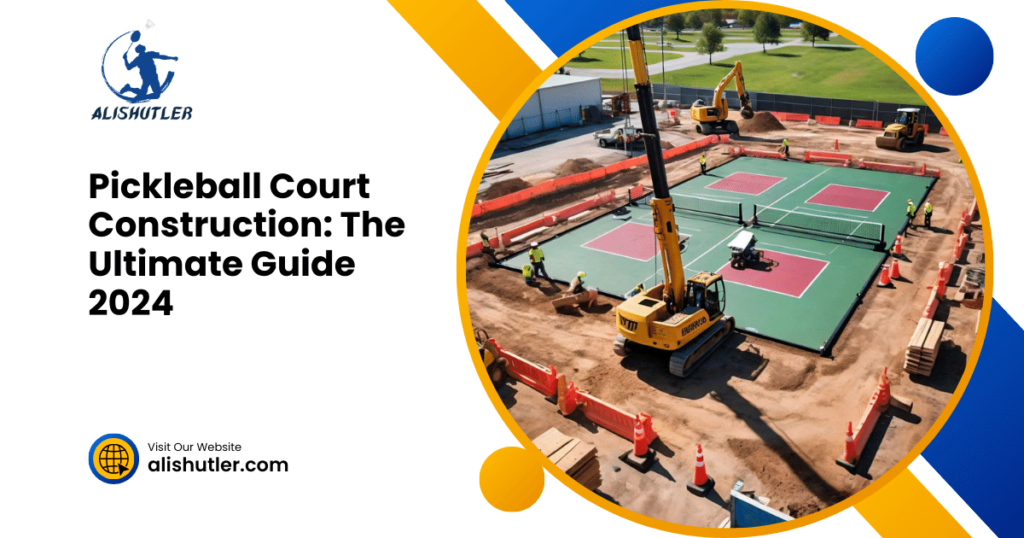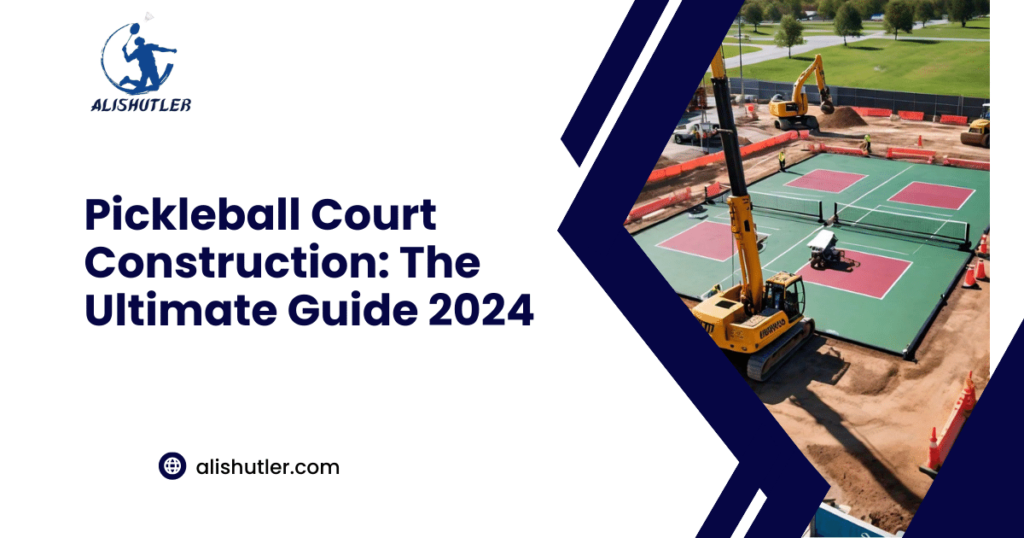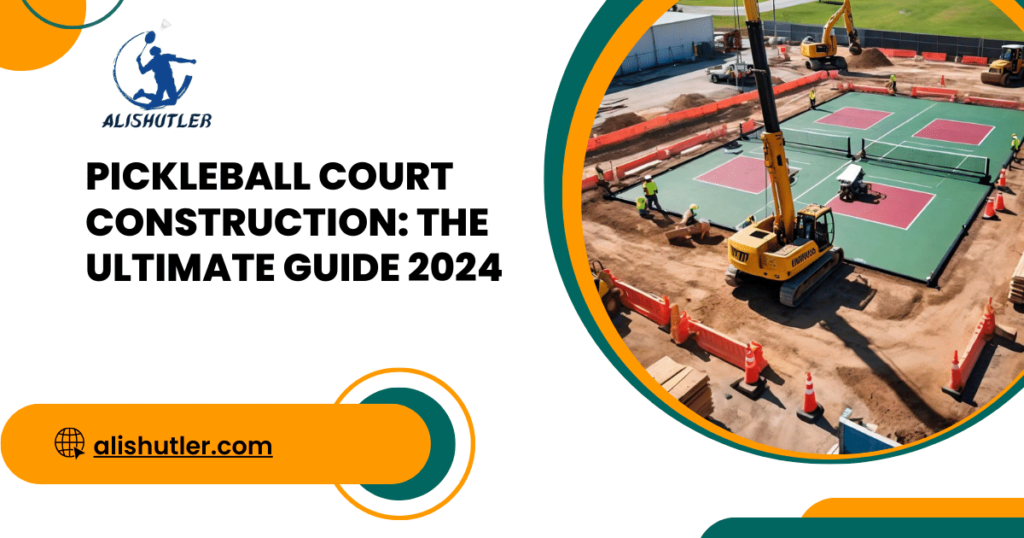Similar to the demand for tennis, pickleball has been rapidly expanding and requires a developed court structure. It is very important to know the details and aspects of a pickleball court in order to sustain it for longer and to encourage players to continue playing on it. From surface materials to proper dimensions, every detail contributes to a successful playing experience.
By delving into the historical context of pickleball court construction development, we can appreciate the evolution of construction techniques and standards that shape today’s courts.
Key Takeaways
- Assess the available space carefully to ensure it meets the required dimensions for a pickleball court, including buffer zones for safety and playability.
- Select the court surface based on factors like climate, maintenance, and player comfort. Opt for materials like asphalt, concrete, or specialized pickleball court tiles for durability and performance.
- Perimeter fencing is essential to prevent balls from straying and ensure a clear boundary for gameplay. Install sturdy fencing that is at least 10 feet high to contain the ball effectively.
- In the selection of net systems, it is crucial to put preference to the ones that can be adjusted as such that they are for different skill levels and different ages. Ensure the materials used are steel that is powder coated for resistance to unruly weather conditions.
- Thus, learn standard court dimensions to avoid unjustified advantages or disadvantages in competitions. Be careful to measure the precise lengths for the court’s width and length and the height of the net for strict regulation within the court.
- It is crucial to use construction materials obtained from trusted manufacturers to ensure long-standing high-performance courts for pickleball. The used paint should be durable as well as resistant to weather if applicable; nets, posts, and fencing must be likewise.
Assessing Space for Court
Measure Space
When identifying the dimensions of the location in which the pickleball court is to be installed, it is essential to ensure the correct data flow. A regulation pickleball court is divided into two sections that are 20 feet by 20 feet each with the remaining 4 feet in total length being divided by a 21 inch wide can for a total of 720 square feet.
Consider Orientation
The angle and orientation of the court are crucial factors to consider. Position the court to minimize sun glare, ensuring optimal playing conditions for participants.
One of the most important decisions for those building a pickleball court is whether they prefer an asphalt or a concrete foundation.
Selecting Court Surface
Base Material
Take care to level the ground to avoid anything that would affect the playing of the game constructively. Asphalt offers a softer surface, reducing player fatigue, while concrete provides a more durable option.
Consider the surfacing requirements to ensure the court meets recommended specifications. It is therefore very important to ensure that a good slope and drainage is present to avoid water stagnation and leaching of the base- course and decrease the likelihood of injury and lessen the court’s service life.
Acrylic Coatings
For the court finish, opt for 100% acrylic coatings such as PickleMaster. These coatings offer durability, resistance to weather elements, and provide a non-slip footing essential for player comfort and safety.
- Pros of Asphalt Base:
- Softer surface reduces player fatigue.
- Cost-effective option for construction.
- Cons of Concrete Base:
- May require more maintenance over time.
- Initial installation costs can be higher than asphalt.
- Consider Player Comfort:
- Ensure that the chosen surfacing material enhances player experience.
- Factors like shock absorption and grip play crucial roles in player performance.
- Choose Durable Finishes:
- Opt for color coatings and acrylic resurfacers that withstand heavy foot traffic.
- Pick standard colors that enhance visibility of the ball during gameplay.
Installing Perimeter Fencing

Durable Materials
The optimal choice for material for the perimeter fencing of a pickleball court includes vinyl or chain-link fencing. These materials guarantee durability and resist adverse weather conditions thus they are cost effective and durable. This chain-link fencing is transparent and strong and provides these benefits. This type of fencing serves the purpose of safety by allowing the players to view what is on the other side in case they continue to run into the fence while in the game.
Suitable Height
The fence around the court should just be high enough to catch the ball within the court. A typical pickleball court will require 20“ width and 44”length for a doubles division. This is why the fencing should be very high so that no balls are able to leave the playing field during the matches.
- Chain-link or vinyl materials
- Enhanced visibility and durability
- Suitable height to contain balls within the court
Choosing Net Systems
Nets
When selecting a net system for your pickleball court, opt for high-quality nets that meet official regulations. These nets ensure fair play and accuracy during matches.
Permanent Nets
For a more professional setup, consider permanent nets that are durable and designed for long-term use. They provide stability and reliability for consistent gameplay.
Portable Options
Portable net systems offer flexibility in court setup, allowing you to easily adjust the court layout as needed. They are ideal for locations where a permanent net installation is not feasible.
Understanding Court Dimensions
Court Sizes
Pickleball court dimensions are crucial for a fair and enjoyable game. Familiarize yourself with the USA Pickleball Rule Book’s recommended sizes. The standard playing lines measure 20’ x 44’ on a regular court.
Optimal Size Choice
For an enhanced playing experience, opt for a larger court size of 34’ x 64’. This choice offers more room for strategic plays and movement.
When constructing a pickleball court, ensuring the correct dimensions is essential. A standard court size guarantees fair gameplay and adherence to official regulations. Choosing the optimal court size of 34’X64’ feet provides players with ample space to showcase their skills effectively.
- Pros:
- Fair gameplay ensured by following official regulations.
- Enhanced player experience with more strategic options.
- Cons:
- Larger court size may require more space for construction.
- Maintenance costs might slightly increase due to the larger area.
Remember, the right court dimensions not only impact gameplay but also contribute to player satisfaction and overall enjoyment of the sport.
Sourcing Materials

Qualified Referrals
When sourcing materials for pickleball court construction, reach out to SportMaster Sport Surfaces for qualified contractor referrals. Their expertise ensures a smooth process from start to finish.
Premium Court Surface
Consider using PickleMaster, the official court surface of USA Pickleball, for a premium playing experience. Its high-quality materials guarantee durability and player satisfaction.
Shock Absorption
Explore ProCushion layers for shock absorption without compromising ball bounce. These layers enhance player comfort and safety during intense gameplay sessions.
Those looking to save more should consider energy efficient type, such as LED, for lighting. The use of lights can improve illumination on the court in order to enable players to have fun on the court even as the sun sets.
For the court’s coating, opt for durable acrylic surfaces that withstand heavy foot traffic and varying weather conditions. A quality coating ensures longevity and minimal maintenance requirements.
Incorporate essential amenities like seating areas, water stations, and shade structures within your budget to enhance player experience. These additions make the court more inviting and comfortable for all participants.
Final Remarks on Pickleball Court Construction
You’ve now gained insights into the key aspects of constructing a pickleball court, from assessing space and selecting surfaces to choosing net systems and understanding dimensions. By sourcing materials wisely and following these steps diligently, you’re on your way to creating a top-notch court for endless fun and competitive play.

It is important to bear in mind that it is necessary to focus on details in all stages in order to reach a successful final product. It will be easier to do now that you have the knowledge required to implement various plans. Let’s go through how you can perform these steps and follow every instruction with precision. So stick with it and shortly you will have a pickleball court of beautiful quality that will attract pickle ball lovers far and wide.
Frequently Asked Questions
FAQ
How do I assess the space for a pickleball court?
To assess space, ensure a flat area of at least 30×60 feet is available. Measure and mark the dimensions accurately. Consider factors like lighting, drainage, and accessibility for players.
What are the benefits of selecting the right court surface?
Choosing the correct surface impacts gameplay quality, safety, and maintenance. Opt for surfaces like asphalt or concrete for durability, low maintenance, and consistent ball bounce.
Why is installing perimeter fencing important for a pickleball court?
Perimeter fencing enhances safety by preventing balls from rolling off-court. It also defines boundaries clearly, reducing disputes during games and ensuring a professional court appearance.
How do I choose the appropriate net system for my pickleball court?
Select a net system that meets official regulations in height and tension. Look for durable materials like steel or aluminum to withstand outdoor conditions and provide longevity for your court.
What are the standard dimensions to consider when constructing a pickleball court?
The court should be 20×44 for singles and 64×34 for the double’s players. Follow these dimensions for appropriate Gameplay and conforming to the official standards.
Is sourcing high-quality materials essential for building a pickleball court?
rcing quality materials ensures durability, longevity, and player safety. Invest in materials like acrylic paint for court lines, sturdy poles for nets, and durable surfacing to create a professional-grade pickleball court.



